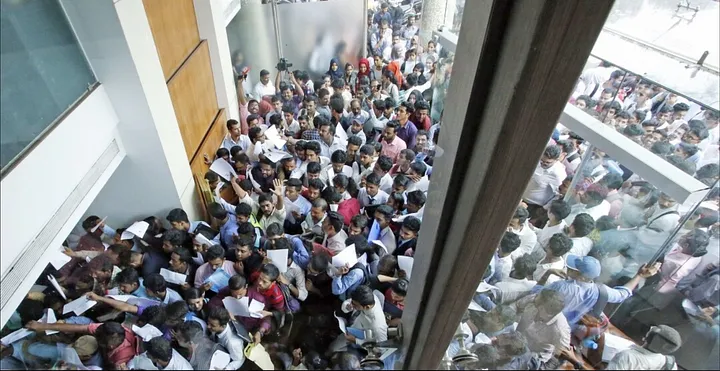Kerala’s Educated Crisis: Will Literacy Lead to Prosperity or Joblessness?
January 27, 2025 2025-01-27 9:41Kerala’s Educated Crisis: Will Literacy Lead to Prosperity or Joblessness?

Kerala’s Educated Crisis: Will Literacy Lead to Prosperity or Joblessness?
By – Anagha S and Theresa Jose
Kerala, often celebrated for its impressive literacy rate of approximately 94%, faces an ironic challenge: high youth unemployment among its educated populace. This paradox highlights systemic issues within the state’s job market and raises questions about the efficacy of its economic and employment strategies. Addressing these challenges is crucial to unlocking sustainable economic growth in one of India’s most literate states.
Employment and Underemployment: A Grim Reality
Kerala’s unemployment crisis is compounded by a significant underemployment issue, reflecting deeper structural inefficiencies in its labour market. According to the Periodic survey of 2023- 2024, individuals aged 15-29, the youth unemployment rate for 2023-2024 stands at 29.9%, nearly three times the national average of 10.2%. The situation is particularly dire for women, with female youth unemployment soaring to 47.1%, compared to 19.3% for men in the same age group. This glaring gender disparity underscores the challenges faced by educated women in accessing meaningful employment opportunities, further highlighted by the stark contrast with the national female youth unemployment rate of just 3.2%.
Adding to the challenge, many educated individuals in Kerala are overqualified for their roles or work in sectors unrelated to their qualifications, reflecting a disconnect between the education system and market demands. The Worker Population Ratio (WPR) in Kerala, at just 50.5%, is lower than that of many other states, indicating that a large portion of the working-age population is either unemployed or not fully engaged in productive work. This underutilization of talent not only stifles individual aspirations but also hinders the state’s economic potential.
Debating the Numbers: Insights from the Assembly
On October 10, 2024, the Kerala Assembly engaged in a heated debate over the findings of the Periodic Labour Force Survey. The opposition United Democratic Front (UDF) raised concerns about the alarmingly high youth unemployment rate of 29.9%, with special emphasis on the 47.1% rate among women, hence there is higher women migration. The UDF argued that these numbers reflect an unsustainable economic trajectory and called for immediate reforms. (Anand, G. (2024))
Finance Minister K.N. Balagopal countered these concerns by pointing out Kerala’s strong performance in Public Service Commission (PSC) appointments. The state accounts for 60% of the country’s PSC recruitments, despite representing only 3% of India’s population. While this achievement is noteworthy, it also highlights Kerala’s over-reliance on government jobs as a primary source of employment.
Government as Provider vs. Mediator: A Need for a Paradigm Shift
Kerala has a high unemployment rate given the high literacy rate, this shows that there is a relation between unemployment and education in Kerala. The state itself is the reason for the recent trend of high educated unemployment mainly because the state has historically invested in education but not in productive activities like manufacturing and services. So there are a lot of educated individuals in the state but little to no job opportunities created in the state which forces these people to seek jobs in other states or go abroad. There is also the issue of low-quality education that has contributed to unemployment as the educational system is not changing with the changing job market trends.
The Kerala Economic Review 2021 highlights that the unemployment rate among educated youth was 14.7% in urban areas and just 8.5% in rural areas. This shows a disparity between urban and rural youth unemployment rates. Even though there is a high urban development in the state with investment in infrastructure and education, there exists structural unemployment due to a mismatch in what the employers demand and the skills the job seekers possess leads to many young graduates not being able to find jobs as they are over-qualified or lack the expected skills for that particular job. This mismatch is resulting in the high unemployment rate in urban Kerala. There is also the issue of underemployment that is seen in the Kerala labour market especially among the educated youth as a large number of educated individuals are forced to take up jobs which are not on par with their skills. There also have been cases where the Kerala youth being educated is not willing to take up any jobs other than white-collared jobs or government jobs which is also reflected in the unemployment rate in Kerala.
Reports suggest that Kerala has a promising rate of new startups. However, the pressing question remains, why have three startups performing the role of one? It’s time for the government to shift its strategy from merely increasing the number of startups to fostering efficiency and impact, rather than creating more cubicle spaces. To tackle these challenges there is a need for the government to prioritize investing in more efficient start-ups which could generate more employment for the youth in Kerala along with that there is a need to provide training to the youth so that they can gain skills. The government should prioritize creating an environment that will help boost employment in the state rather than just providing job opportunities as this action could lead to long-term impact on all individuals. They must try to foster industrial growth through various initiatives by the government and also through policies and schemes that could attract more investment, support startups and create an entrepreneur-friendly environment which could lead to an increase in employment opportunities in the state. The state can create more opportunities through more participation in para-diplomacy which could help in strengthening the diplomatic ties is a need of the hour, especially with states now actively trying to attract FDIs and international partnerships to their state, so Kerala needs to pick up the pace to enhance its competitive edge and become a mediator that could help in creating opportunities for the people of Kerala. More collaboration between educational institutions and industries is encouraged so that it could provide a more significant learning experience for the students and will lead to them being able to acquire skills that align with the needs of the employers and eventually help in driving economic progress.
Conclusion: The Irony Kerala Cannot Afford
Kerala’s paradox of high literacy and soaring unemployment raises a critical question: how can a state celebrated for its education fail to create opportunities for its youth? Despite urban development, why are job prospects so scarce for the educated? Is the over-reliance on government jobs, the mismatch between education and industry needs, or the neglect of its global networks holding Kerala back? To break free from outdated models, shouldn’t Kerala focus on empowering local employment and creating an environment where ambition is rewarded with real opportunities? Can the state afford to let its educated youth remain its most underutilized asset? The time to act is now. Will Kerala let the promise of literacy become the curse of joblessness, or will it rise to redefine its growth model and ensure a future that turns potential into progress?
References
Anand, G. (2024, October 10). Kerala Assembly: Opposition stages walkout after clash with Left govt over youth unemployment. The Hindu. https://www.thehindu.com/news/national/kerala/kerala-assembly-opposition-stages-walkout-after-wrangling-with-left-govt-over-youth-unemployment/article68739722.ece
Barua, K. (2024, September 29). Top 10 Indian states with highest unemployment rates. Jagranjosh.com. https://www.jagranjosh.com/general-knowledge/indian-states-with-highest-unemployment-rates-1727625463-1
ECONOMIC REVIEW 2017 | State Planning Board, Thiruvananthapuram, Kerala, India. (n.d.). https://spb.kerala.gov.in/economic-review/ER2017/web_e/ch412.php?id=41&ch=412
John, J. V. (2024, August 23). Strategic Para-Diplomacy: Reimagining Kerala’s Engagement with a Changing World – Centre for Public Policy Research (CPPR). Centre for Public Policy Research (CPPR). https://www.cppr.in/articles/strategic-para-diplomacy-reimagining-keralas-engagement-with-a-changing-world
Kerala Startup Mission. (n.d.). Kerala Startup Mission. https://startupmission.kerala.gov.in/programs/csr/ksum.html#:~:text=Kerala%20Startup%20Mission%20.
Muneer, N. K., & Kumar, D. (2019). TREND AND FEATURES OF UNEMPLOYMENT IN KERALA; ANALATICAL STUDY. In Journal of Emerging Technologies and Innovative Research (JETIR), Journal of Emerging Technologies and Innovative Research (Vol. 6, Issue 4, pp. 677–678) [Journal-article]. https://www.jetir.org/papers/JETIR1904N91.pdf
N.P., Abdul. (2019). Educated Unemployment: A Case Study of Kerala International Journal of Education for the 21st Century, Vol. 1(1), PP: 93-120, July- December, ISSN 2349-5774. 1. 93-120. https://www.researchgate.net/publication/331702955_Educated_Unemployment_A_Case_Study_of_Kerala_International_Journal_of_Education_for_the_21st_Century_Vol_11_PP_93-120_July-_December_ISSN_2349-5774
Onestop Kerala. (n.d.). Kerala’s industrial and business growth: A transformative journey in recent years. Onestop Kerala. https://onestopkerala.com/keralas-industrial-and-business-growth-a-transformative-journey-in-recent-years/
Periodic Labour Force Survey (PLFS) – Annual Report [July, 2023 – June, 2024]. (n.d.). https://pib.gov.in/PressReleasePage.aspx?PRID=2057970
Tnn. (2024, September 24). Youth unemployment rate in Kerala among highest in India. The Times of India. https://timesofindia.indiatimes.com/india/youth-unemployment-rate-in-kerala-among-highest-in-india/articleshow/113645082.cms






